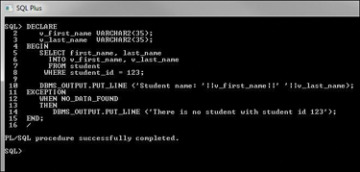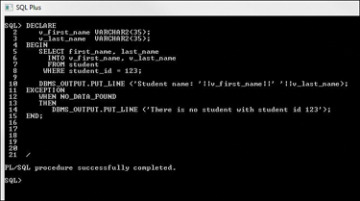- Lab 1.1: PL/SQL Architecture
- Lab 1.2: PL/SQL Development Environment
- Lab 1.3: PL/SQL: The Basics
- Summary
Lab 1.2: PL/SQL Development Environment
SQL Developer and SQL*Plus are two Oracle-provided tools that you can use to develop and run PL/SQL scripts. SQL*Plus is an old-style command-line utility tool that has been part of the Oracle platform since its infancy. It is included in the Oracle installation on every platform. SQL Developer is a free graphical tool used for database development and administration. It is available either as a part of the Oracle installation or via download from Oracle’s website.
Due to its graphical interface, SQL Developer is a much easier environment to use than SQL*Plus. It allows you to browse database objects; run SQL statements; and create, debug, and run PL/SQL statements. In addition, it supports syntax highlighting and formatting templates that become very useful when you are developing and debugging complex PL/SQL modules.
Even though SQL*Plus and SQL Developer are two very different tools, their underlying functionality and their interactions with the database are very similar. At runtime, the SQL and PL/SQL statements are sent to the database. After they are processed, the results are sent back from the database and displayed on the screen.
The examples used in this chapter are executed in both tools to illustrate some of the interface differences when appropriate. Note that the primary focus of this book is learning PL/SQL; thus, these tools are covered only to the degree that is required to run PL/SQL examples provided by this book.
Getting Started with SQL Developer
Whether SQL Developer has been installed as part of the Oracle installation or as a separate module, you need to create at least one connection to the database server. You can accomplish this task by clicking the Plus icon located in the upper-left corner of the Connections tab. Clicking this icon activates the New/Select Database Connection dialog box, as shown in Figure 1.4.
In Figure 1.4, you need to provide a connection name (ORCLPDB_STUDENT), username (student), and password (learn).

Figure 1.4 Creating a Database Connection in SQL Developer
In the same dialog box, you need to provide database connection information such as the hostname (typically, the IP address of the machine or the machine name where the database server resides), the default port where that database listens for the connection requests (usually 1521), and the SID (system ID) or service name that identifies a particular database. Both the SID and service name would depend on the names you picked up for your installation of Oracle. The default SID for the pluggable database is usually set to ORCLPDB.
After the connection has been successfully created, you can connect to the database by double-clicking the ORCLPDB_STUDENT. By expanding the ORCLPDB_STUDENT (clicking the plus sign located to the left of it), you can browse various database objects available in the STUDENT schema. For example, Figure 1.5 shows list of tables available in the STUDENT schema. At this point you can start typing SQL or PL/SQL commands in the Worksheet window.

Figure 1.5 List of Tables in the STUDENT Schema
To disconnect from the STUDENT schema, you need to right-click the ORCLPDB_STUDENT and click the Disconnect option. This action is illustrated in Figure 1.6.

Figure 1.6 Disconnecting from a Database in SQL Developer
Getting Started with SQL*Plus
You can access SQL*Plus via the Programs menu or by typing sqlplus in the command prompt window. When you open SQL*Plus, you are prompted to enter the username and password (student or student@orclpdb and learn, respectively).
After successful login, you are able to enter your commands at the SQL> prompt. This prompt is illustrated in Figure 1.7.

Figure 1.7 Connecting to the Database in SQL*Plus
To terminate your connection to the database, type either EXIT or QUIT command and press Enter.
Executing PL/SQL Scripts
As mentioned earlier, at runtime SQL and PL/SQL statements are sent from the client machine to the database. After they are processed, the results are sent back from the database to the client and are displayed on the screen. However, there are some differences between entering SQL and PL/SQL statements.
Consider the following example of a SQL statement.
For Example
SELECT first_name, last_name FROM student WHERE student_id = 102;
If this statement is executed in SQL Developer, the semicolon is optional. To execute this statement, you need to click the triangle button in the ORCLPDB_STUDENT SQL Worksheet or press the F9 key on your keyboard. The results of this query are then displayed in the Query Result window, as shown in Figure 1.8. Note that the statement does not have a semicolon.

Figure 1.8 Executing a Query in SQL Developer
When the same SELECT statement is executed in SQL*Plus, the semicolon is required. It signals SQL*Plus that the statement is terminated. As soon as you press the Enter key, the query is sent to the database and the results are displayed on the screen, as shown in Figure 1.9.

Figure 1.9 Executing a Query in SQL*Plus
Now, consider the example of the PL/SQL block used in the previous lab.
For Example ch01_1a.sql
DECLARE
v_first_name VARCHAR2(35);
v_last_name VARCHAR2(35);
BEGIN
SELECT first_name, last_name
INTO v_first_name, v_last_name
FROM student
WHERE student_id = 123;
DBMS_OUTPUT.PUT_LINE ('Student name: '||v_first_name||' '||
v_last_name);
EXCEPTION
WHEN NO_DATA_FOUND
THEN
DBMS_OUTPUT.PUT_LINE ('There is no student with student id
123');
END;
Note that each individual statement in this script is terminated by a semicolon. Each variable declaration, the SELECT INTO statement, both DBMS_OUTPUT.PUT_LINE statements, and the END keyword are all terminated by the semicolon. This syntax is necessary because in PL/SQL the semicolon marks termination of an individual statement within a block. In other words, the semicolon is not a block terminator.
Because SQL Developer is a graphical tool, it does not require a special block terminator. The preceding example can be executed in SQL Developer by clicking the triangle button in the ORCLPDB_STUDENT SQL Worksheet or pressing the F9 key on your keyboard, as shown in Figure 1.10.

Figure 1.10 Executing a PL/SQL Block in SQL Developer
The block terminator becomes necessary when the same example is executed in SQL*Plus. Because it is a command-line tool, SQL*Plus requires a textual way of knowing when the block has terminated and is ready for execution. The forward slash (/) is interpreted by SQL*Plus as a block terminator. After you press the Enter key, the PL/SQL block is sent to the database, and the results are displayed on the screen. This is shown in Figure 1.11 on the left.
If you omit /, SQL*Plus will not execute the PL/SQL script. Instead, it will simply add a blank line to the script when you press the Enter key. This is shown in Figure 1.11 on the right, where lines 16 through 20 are blank.


Figure 1.11 Executing a PL/SQL Block in SQL*Plus with a Block Terminator and Without a Block Terminator